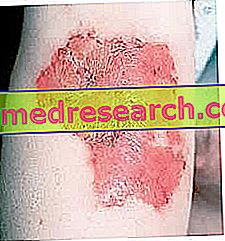Generality
Visual aura is a set of neurological transient symptoms that precede or accompany particular forms of headache .

In detail, these manifestations influence vision and more commonly include: increased sensitivity to light (photophobia), visual blurring, phosphenes (perception of flashes and flashes of light) and scotomas (vision of dark or colored spots). The visual aura can be associated with other reversible disorders, including nausea, dizziness and tingling in the upper limbs, loss of appetite, increased sensitivity to sounds and changes in mood.
Headaches are generally migraine-like and appear within an hour or so from the end of the visual aura, but can sometimes be contemporary .
Although the causes at the origin of this disorder are not yet entirely clear, many factors can trigger or aggravate the attacks of headache with visual aura, such as, for example: stress, hormonal imbalances, strong smells and noises, climatic changes, physical activities too intense, bad posture and poor sleep quality.
The diagnosis is clinical and is based on an accurate collection of clinical history and physical examination.
In subjects who have infrequent episodes of visual aura, the treatment is exclusively symptomatic and involves the use of analgesics and anti-inflammatories from self-medication, such as ibuprofen and naproxen. In the case of recurrent or particularly serious attacks, prophylaxis therapy is indicated, similar to that used for aura-free headache.
What's this
A VISUAL AURA means a series of changes in vision (flashes of light, sparkling images, stars, zigzag lines, etc.) that precedes a headache attack, usually of a migraine type. These manifestations are completely transient and reversible.
Forms of headache with visual aura
Visual aura is a common and generally intense phenomenon in MIGRAINE . However, similar vision disorders have also been described in association with other types of primary headache, such as CEFALEA TENSIVA and CEFALEA A GRAPPOLO . The visual aura affects both eyes more frequently.
MIGRAINE WITH AURA
- Migraine with aura is a primary headache (headache is therefore not caused by other diseases). In this condition, pain attacks can be heralded by prodromal symptoms, that is, by the sensation that the migraine is about to begin. Sometimes, these manifestations may persist even after the onset of the headache.
- The disorders that characterize migraine with aura include feelings of numbness, nausea, loss of appetite, mood changes, increased sensitivity to light or sound, visual blurring and scotomas. Usually, these events last from 5 to 20 minutes (they never last for more than an hour). Migraine usually appears within an hour or so from the end of the visual aura and persists for a long time (from 4 hours up to 2-3 days borderline cases).
- The migraine aura usually involves both eyes; the visual symptoms are of short duration.
- The average presence of migraine in the adult population is around 12% (18% in women and 6% in men); the visual aura precedes headache attacks in about a third of cases.
Aura typical or without migraine
From the clinical point of view, different variants of migraine with aura are recognized (classical form, with acute onset, with prolonged aura, without headache etc.). In the isolated visual aura (or without headache), for example, the prodromal symptoms may occur without being followed by a headache crisis. The rarest forms of migraine with aura are characterized by particular neurological symptoms, such as loss of strength up to paralysis of a part of the body ( hemiplegic migraine ) or other disturbances of balance and consciousness ( basilar migraine ).
OPHTHALMIC MIGRAINE
- Ophthalmic migraine is a particular form of headache accompanied by transient visual disturbances. Usually, the pain affects only one side of the skull and appears within an hour of the onset of visual symptoms (also with unilateral involvement). An episode of ophthalmic migraine lasts from a few minutes to several hours.
- Unlike other forms of headache, the visual aura in ophthalmic migraine is related to the sudden narrowing of the blood vessels supplying the eye and its structures, which results in a temporary reduction in local blood flow. Among the factors that can trigger this form of headache are also incorrect sight defects (refractive defects, such as myopia, hypermetropia or astigmatism), asthenopia (eye fatigue), pathologies that make vision difficult (eg cataract) and trigeminal nerve neuralgia.
- Ophthalmic migraine is more common in young women (usually within the age of 40). Furthermore, the disorder occurs more commonly in subjects who have a personal or family predisposition to manifest a migraine with aura.
Warning! In some cases, the medical term " ophthalmic migraine " can lead to confusion. This can in fact be used interchangeably to refer to the migraine aura and retinal migraine . In reality, these terms are not synonymous, but indicate different pathological conditions compared to ophthalmic migraine.
- MIGRAINE AURA coincides with the typical aura that precedes or in some cases accompanies a migraine headache (ie migraine with aura ). In general, auras are very different transient neurological disorders, which can affect vision, balance, muscle coordination, sensations or speech. The visual variant represents the most common type of aura .
- RETINAL MIGRAINE is, on the other hand, a rather rare disorder that involves intense pain located behind the eyeballs . Usually, these episodes are repeated and last several hours. Retinal migraine is anticipated by visual disturbances (sparking flashes and dark punctate areas) always at the expense of the same eye and followed by a transient partial or complete loss of sight. The causes can be attributed to a retinal vasospasm or to an ocular form of migraine infarction (both represent very serious pathological conditions). Despite the similarities with the transient and completely reversible visual symptoms associated with headache with aura, with which it can be confused, retinal migraine can induce severe consequences, such as a permanent monocular blindness (not in both eyes). For this reason, timely medical intervention is required.
Causes and Risk Factors
The correlations between visual aura and headache are not yet fully understood. However, in the same way as with headache, it appears that this condition may depend on an alteration of the pain regulation system and an abnormal neurological response to certain stimuli.
The triggering of these particular mechanisms can induce various phenomena including a sudden constriction of the cerebral vessels, with a consequent reduction in the blood supply in some brain areas. The physiological effect thus determined can justify the appearance of visual aura symptoms ; the subsequent phase of vasodilation coincides, instead, with the onset of the actual headache .
The visual aura is more common in the female sex, it can affect all age groups and seems to be associated with a family predisposition.
Aggravating and / or triggering factors
The factors that favor and trigger a migraine episode with visual aura are numerous and include:
- Dehydration;
- Excessive heat, wind and climatic variations;
- High altitudes;
- Anxiety, emotional tension, depression, stress or slack (as happens on weekends and on vacation);
- Excessive afferent stimuli (eg too intense or flashing exposure to the sun or light, smoke, strong smells and noises, etc.);
- Hypertension;
- Hypoglycemia;
- Fluctuation in hormone levels (menstruation, oral contraceptive use and menopause);
- Too intense or particularly strenuous physical activities;
- Bad posture;
- Use of some drugs (eg vasodilators, birth control pills, etc.);
- Consumption of particular foods, fasting or unbalanced diet (eg excess sodium or abuse of sausages, aged cheeses, nitrites, glutamate, aspartame and chocolate);
- Abuse of alcoholic or caffeinated beverages;
- Poor sleep quality or changes in sleep / wake rates;
- Inflammation of the trigeminal nerve;
- Temperature;
- Systemic diseases of various kinds, such as atherosclerosis, systemic lupus erythematosus or sickle cell anemia.
The manifestations that characterize the visual aura can also be favored by specific visual pathologies, such as:
- Incorrect visual defects (myopia, hyperopia or astigmatism);
- Eye strain (asthenopia);
- Ocular diseases that make vision difficult (as in the case of cataracts).
Symptoms and Complications
The symptoms of the visual aura do not appear in an acute way, but develop gradually within at least 5 minutes and vanish completely within an hour (on average they last 20-30 minutes and, in some cases, can persist after the onset of the illness head). Other times, there is only visual aura without headache.
The migraine aura may be associated with other manifestations, such as numbness, nausea, vomiting and increased sensitivity to light or sound. Visual symptoms also include flashes or sparkles, dark spots, flashes of light and blind spots.
The visual aura can temporarily interfere with some activities, such as reading or driving, but the condition is not to be considered serious.
Aura: visual disturbances
The symptoms that characterize the visual aura include:
- Photophobia (hypersensitivity to light);
- Image distortion;
- Difficulty focusing;
- Darkening of half of the visual field (hemianopsia);
- Blurred vision;
- Increased tearing;
- Vision of blind spots, dark or colored, fixed or sparkling in the visual field (scotomas);
- Perception of flashes of light or flash in the absence of light;
- Partial loss of vision or temporary blindness.
These manifestations are completely reversible . Usually, the visual aura lasts 5 to 20 minutes (the episodes never last for more than an hour). The headache that follows or manifests itself simultaneously, however, persists longer (from 4 hours up to 2-3 days borderline cases).
Headache with visual aura: characteristics
The headache that is preceded and accompanied by the visual aura appears within an hour from the onset of the latter and, usually, is of a pulsating character and of moderate or severe intensity. During a migraine attack, the area where the headache is located can change position and progressively increase in intensity. The onset usually involves the anterior or lateral part of the head above the eye; later, the headache evolves into dull pain and the sensation of pulsation can become bilateral or spread to the region of the forehead and temples.
Headache with a visual aura may be aggravated during daily activities (eg walking or climbing steps) and may be associated with a wide variety of focal neurological symptoms that accompany or follow visual disturbances:
- Repulsion for food, nausea and / or vomiting (in particularly strong crises);
- Hypersensitivity or discomfort due to odors (osmophobia) and noise (phonophobia);
- Dizziness;
- Decreased muscle strength;
- Tingling, numbness and reduced sensitivity of a limb or half of the body (typically, paresthesias begin in one hand, spread to the arm and may involve the ipsilateral half-life);
- Loss of sensitivity in the palate;
- Difficulty in expressing words verbally and articulating (aphasic type language disorders);
- Hindrance in the movements of an extremity.
In general, these symptoms occur in sequence: first the visual aura begins, then the sensory disturbances and finally those of language appear.
Diagnosis
An accurate personal and family history is usually sufficient to establish the appearance of the visual aura: the doctor can diagnose the presence of a form of headache associated with this phenomenon by collecting information related to the clinical history and symptoms reported by the patient. Therefore, the person is invited to describe the intensity and location of the pain, the frequency of the attacks and any disturbances felt before or during crises.
However, some pathological conditions can cause similar disorders, such as in the case of serious eye diseases, epilepsy, stroke and carotid dissection. In this regard, when the visual aura is very intense, does not respond to common analgesics or becomes a habitual disorder, it is good to contact your primary care physician, carry out a very thorough eye examination and request a neurological consultation at a care center of headaches.

Sometimes, to exclude other conditions able to mimic the visual aura, the diagnostic path can make use of more in-depth diagnostic investigations, such as computerized tomography (CT), magnetic resonance imaging and electroencephalogram (especially in children). Additional tests may also include blood tests, x-ray of the cervical spine, ecodoppler and lumbar puncture.
Differential diagnosis
Before making the diagnosis of visual aura, it is important to exclude other conditions that can occur with a very similar clinical picture (even if the cases are rare), such as:
- Serious eye problems;
- Arteriovenous malformations;
- Epilepsy;
- Consequences of a stroke or those of a head injury;
- Carotid dissection;
- Optic neuritis.
Therapy
Dealing adequately with the visual aura headache helps reduce the frequency of attacks and limits the associated discomforts.
The first step to be implemented to manage and prevent episodes consists in reducing or, if possible, eliminating the triggers, implementing some lifestyle changes (eg habits related to sleep or diet). If the control of these stimuli is ineffective, it is possible to resort to drug therapy .

In any case, the most appropriate approach to the visual aura must always take into account the individual indications established by the doctor, formulated in relation to the extent of the disorder, the symptoms and the personal needs of the patient.
Symptomatic treatment
In subjects who experience few episodes of headache with a visual aura over the course of a year, the pharmacological treatment is aimed at alleviating pain and rapidly controlling the associated symptoms.
Among the drugs most used in symptomatic therapy are non-steroidal anti-inflammatory drugs ( NSAIDs, such as aspirin or ibuprofen) and triptans (vasoconstrictor active ingredients).
Preventive treatment
In some cases, it is useful to use a prophylactic or preventive drug therapy against headache with aura.
When the disorder often occurs (at least 5 seizures per month) or the symptoms are very serious, a neurologist who specializes in treating headaches can indicate a prophylaxis therapy, aimed at reducing the frequency and severity of attacks. This type of drug treatment involves taking regular medication, often on a daily basis.
The main classes of medicines are:
- Beta blockers and calcium channel blockers : modulate the tone of blood vessels and regulate the mechanisms involved in pain;
- Tricyclic antidepressants : such as amitriptyline or nortriptyline, they act mainly on serotonin receptors;
- Anticonvulsants : like divalproex sodium and topiramate, they act on the pain threshold and on cerebral hyper-excitability.
The doctor will choose whether to prescribe them based on the frequency of the visual aura attacks, or on the patient's age; following his directions helps to face the problem in the best possible way.
Other useful interventions
A useful strategy to counteract the visual aura and related ailments is the use of glasses to correct any vision defects or prevent excessive eye fatigue.
Another effective intervention consists in acting on all those that may be environmental factors. In the case of headache with visual aura caused by stress, for example, it is possible to resort to natural remedies, such as the intake of valerian, chamomile and lemon balm infusions with a calming action, as well as the practice of yoga.
Prevention
Some dietary-behavioral measures can help to alleviate the symptoms of visual aura and, more generally, of migraine.
These include:
- Avoid factors that can promote the onset of headaches, such as cigarette smoke, poorly ventilated areas, alcohol consumption, excessive heat and exposure to intense noise;
- Limit the consumption of foods that may contain monosodium glutamate, nitrites and lactose implicated in the onset of headache attacks: dairy products, aged cheeses, Chinese food, eggs, chocolate, citrus fruits, tomatoes, etc .;
- Have periodic checkups with a trusted ophthalmologist to prevent the lack of awareness of a given disorder (eg myopia, astigmatism, hyperopia, etc.) from aggravating a visual aura or preparing for any other type of problem.



